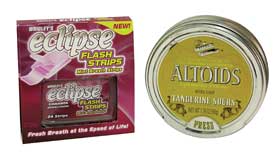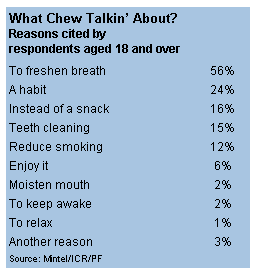
Changing sweeteners has been a boon to sugar-free gums. Indeed, the desire for fresher breath is the top driver for gum consumption, cited as the reason by 56% of respondents to exclusive Mintel (Chicago) consumer research; the numbers are even higher for mint consumption (72%). As Mintel has found, this logic has benefited strong mints and the newer breath strips—to the detriment of older, milder-strength items.
The rise and demise of Altoids, a product of Kraft (Northbrook, Ill.), serves as an example. Its bold, strong flavors overtook Tic Tac to become a consumer favorite in 1999. However, Altoids itself has been pushed to the side in recent years, as consumers have flocked to even stronger mint fresheners and breath strips.
Traditional items are facing pressure to modernize, lest they face steep sales declines. Doublemint and Juicy Fruit from Wm. Wrigley (Chicago) and Certs from Adams (Morris Plains, N.J.) have faced sales troubles. In some cases, newer brand offerings from the same companies have cannibalized their sales. Young adults, traditionally the prime gum and mint users, want to feel that a product is made for them and, therefore, many of these consumers are “put off by marketing messages or older brands that do not resonate with how the kids like to visualize themselves,” explains Mintel.
While Wrigley's updates to the flavor and packaging of several brands may be necessary, even more radical changes may be required. Mintel regards gum and mints as a “lifestyle product” and, as a result, change comes more quickly than other packaged goods. Changing consumer tastes, aesthetics and attitudes will require changes/updates to manufacturers' products.
Some 80% of adults use gum and mints, and among children and teens (aged 6-17) the number is even greater (95%), Mintel reports. With such a strong following, the issue for new products must be encouraging prime users to increase consumption.
Almost a third of teens chew gum more than once a day, so Mintel recommends targeting those in adjacent age groups—notably the lightly using 6- to 11-year-olds and the 18-24 demographic, among whom usage stands at 89%. While still high, that statistic is a significant drop from younger teens and begins a slide that continues throughout adulthood.
Consumption falls to 68% for those 65 and older and, Mintel believes, “looking for new customers at ages 45+ appears to be a key way to expand the business.” This is particularly true considering the 45+ age group will be the fastest-growing demographic through 2010.
Also projected to grow is the gum and mint category. Sales are forecast to jump 13% (in constant dollars), to $4.7 billion, between 2003 and 2007.

Sweet Developments
With new and varied sweeteners being used, gums and mints enjoy the results of sugars that leave different impressions in the mouth, including intensities, textures, as well as benefits such as plaque-fighting and tooth-strengthening. The flurry of innovations and introductions demonstrate the role of functionality—and in some cases, novelty—in the segment. Breath-freshening and dental gums are selling well, as are many of the products in interesting packaging or with catchy advertising. On the down side, traditional products have seen their sales drop.As an example, regular gum still ranks as the category's second largest segment but has seen its sales fall 6% over the last two years, reporting sales declines among all of its major brands. In fact, sales of regular gums have declined every year since 1998. Major players—notably Wrigley—tried to reverse this trend in 2001-2002 by retooling some of the more-established brands, such as Big Red, Spearmint and Doublemint, plus introducing new brands like Everest.
Meanwhile, improvements to non-sugar sweeteners, new developments and strong advertising have boosted sugarless gum to the top of the gum and mints market. The segment also ranks as the category's fastest-growing, jumping 28% between 2000 and 2002.
As manufacturers and consumers have found, gum sweetened with aspartame, sucralose, ace-K or “sugar alcohols,” such as mannitol, xylitol and sorbitol, bring more functionality than ordinary sugar. While adding no more calories than sugar (some add zero calories), these sweeteners deliver a greater sweetness intensity and can add mouthfeel dimensions, such as “cool” or “chewy-but-not-sticky.”
The 7% growth in sales of dental gums and antismoking gums over the same period demonstrates consumers' willingness to look at the product in a different light. They are increasingly viewing gum as a delivery device for health-enhancing ingredients or as a means of avoiding smoking or eating.

Expanding the Purpose
One such example is the partnership between Wrigley and Procter & Gamble (Cincinnati), whereby the Crest brand and “Dual Action Whitening” mention were put on Orbit White gum. Mintel believes, “Such cooperative ventures will become more prevalent, especially as health or pharmaceutical companies should be able to lead in the development of gum and mints with nutraceutical functions.” Similar maneuvers can be expected as the population ages and is made aware of added benefits that can be provided by gum and mints.Gums can be used to suppress the appetite and relieve allergies, to name just two of the potential usages. However, Wrigley's Surpass antacid gum was a prominent failure and, as Mintel notes, “emphasized that some health benefits may be less strongly connected to gum chewing than others.”
The dollar sales growth in anti-smoking gum has slowed recently, though not due to a lack of volume sales. Rather, a generic product has taken a greater share of the market and lowered the per-pack price. Unit sales in the segment maintained a 6% to 9% growth between 1997 and 2001, but Nicorette from GlaxoSmithKline (Philadelphia) captured market share at a lower price than the branded product. In addition, private label anti-smoking gum accounted for nearly 27% of the market in 2002, the first year that unit sales actually flattened.
Dental gum saw slowing sales increases after 2000, but several 2002 marketing initiatives offer hope for the future of the segment. Several major brands of dental gum debuted between 1998 and 2000, but they are priced at a premium, compared to other sugarless gums. With such ingredients as Recaldent, a milk-derived combination of calcium and phosphorous, and the sweetener Xylitol, dental gum is positioned as a good substitute when consumers are unable to brush their teeth.
Breath mints have seen marginal sales declines in recent years. The strong sales growth in the mid-1990s for breath mints stalled from 2000-2002, amid the debut of breath strips and stronger competition from newer sugarless gum.

For the gum and mints category, Mintel expects total retail sales to grow 27% from 2002-2007, driven by new product introductions for consumers in each different age group. Sales could be driven higher should more sugar-free mints make their way to market, and manufacturers develop products to meet the needs of older adults. However, less-exemplary sales growth could result if private-label products gain a larger share of the total market.
For more information on the report, “The U.S. Gum & Mints Market,” contact Mintel International Group Ltd.; 213 W. Institute Place, Suite 208; Chicago, IL 60610; phone: 312-932-0400.

Website Resources
www.GNPD.com — Global New Products Databasewww.kraft.com — Kraft
www.altoids.com — Altoids
www.wrigley.com — Wrigley
www.certs.com — Certs
www.pg.com — Procter & Gamble
www.gsk.com — GlaxoSmithKline
